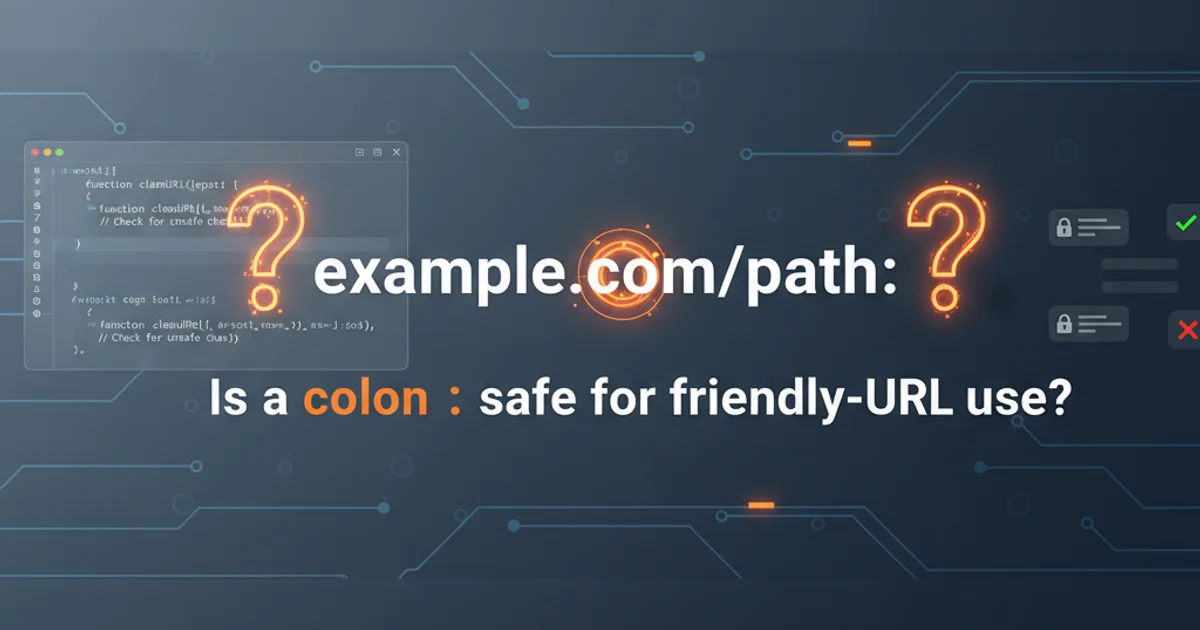Is a colon `:` safe for friendly-URL use?
: safe for friendly-url use? with practical examples, diagrams, and best practices. Covers url, gwt, special-characters development techniques with visual explanations.Categories:
Is the Colon (:) Safe for Friendly URLs?

Explore the technical implications and best practices for using colons in URLs, focusing on their safety and compatibility across different systems and standards.
When designing 'friendly URLs' – URLs that are human-readable and semantically meaningful – developers often encounter questions about which special characters are safe to use. The colon (:) is one such character that frequently sparks debate. While it has specific reserved meanings within the URI (Uniform Resource Identifier) syntax, its use in the path segment of a URL for aesthetic or organizational purposes can lead to unexpected behavior or compatibility issues. This article delves into the technical specifications, practical considerations, and best practices for using or avoiding colons in your friendly URLs.
Understanding URI Syntax and Reserved Characters
To properly assess the safety of the colon, it's crucial to understand how URIs are structured and which characters are considered 'reserved' by RFC 3986. Reserved characters have a special meaning within the URI syntax, acting as delimiters or separators. If a reserved character is used for a purpose other than its defined delimiter role, it must be percent-encoded (e.g., %3A for a colon). Non-reserved characters, on the other hand, can be used directly.
flowchart TD
A[URI Structure] --> B{Scheme:}
B --> C[//Authority]
C --> D[/Path]
D --> E[?Query]
E --> F[#Fragment]
subgraph Reserved Characters
G[":" (Colon)]
H["/" (Slash)]
I["?" (Question Mark)]
J["#" (Hash)]
K["[" (Left Bracket)]
L["]" (Right Bracket)]
M["@" (At Sign)]
N["!" (Exclamation Mark)]
O["$" (Dollar Sign)]
P["&" (Ampersand)]
Q["'" (Single Quote)]
R["(" (Left Parenthesis)]
S[")" (Right Parenthesis)]
T["*" (Asterisk)]
U["+" (Plus Sign)]
V["," (Comma)]
W[";" (Semicolon)]
X["=" (Equals Sign)]
end
G --> B
G --> D
G --> E
G --> F
style G fill:#f9f,stroke:#333,stroke-width:2pxURI Structure and Reserved Characters according to RFC 3986
The colon (:) is explicitly listed as a reserved character. Its primary role is to separate the scheme from the rest of the URI (e.g., http:). While RFC 3986 allows reserved characters to appear unencoded in the path segment if they do not conflict with a delimiter's role, this is where the ambiguity and potential for issues arise. Different parsers, web servers, and client-side applications might interpret or handle unencoded colons in the path differently.
Potential Issues and Practical Considerations
Using colons in URL paths, even if technically allowed under certain interpretations of RFCs, can lead to several practical problems. These include inconsistent parsing, issues with routing frameworks, and potential conflicts with future URI specifications or web server configurations.
1. Web Server and Framework Interpretation
Some web servers (like Apache or Nginx) or application frameworks (like Spring, Ruby on Rails, or even GWT's history management) might have their own URL parsing rules or default configurations that treat colons specially. For instance, some frameworks might interpret a colon as a separator for parameters or as part of a regular expression pattern for routing. This can lead to routing failures or incorrect parameter extraction.
2. Browser and Client-Side Behavior
While modern browsers are generally robust, older browsers or specific client-side JavaScript libraries might handle unencoded colons inconsistently, especially when dealing with window.location manipulation or AJAX requests. This can lead to broken links or unexpected navigation.
3. SEO and Readability
While the goal is 'friendly URLs,' introducing characters that require percent-encoding or are uncommon can detract from readability. A URL like /products/category:subcategory might look clean, but if it's internally treated as /products/category%3Asubcategory, it loses some of its 'friendliness' and can be confusing for users if they see the encoded version.
4. Cross-Platform Compatibility
If your application interacts with various external systems, APIs, or content management systems, using non-standard characters in URLs increases the risk of compatibility issues. Some systems might strictly adhere to percent-encoding for all reserved characters when they are not used as delimiters.
Best Practices for Friendly URLs
Given the potential pitfalls, the consensus among web development best practices is to keep URLs as simple and predictable as possible. This often means limiting characters to the unreserved set or using common, widely accepted separators.
1. Prefer Hyphens for Separation
Use hyphens (-) to separate words in URL segments. This is the most widely accepted and SEO-friendly practice.
2. Avoid Reserved Characters
As a general rule, avoid using any reserved characters (including :, /, ?, #, &, =, etc.) in your URL path segments unless they are serving their specific delimiter purpose. If you must include data that contains these characters, percent-encode them.
3. Use Slugs
Convert titles or names into 'slugs' – URL-friendly versions that typically consist of lowercase letters, numbers, and hyphens. Many frameworks provide utilities for this.
4. Consider Alternatives for Hierarchical Data
If you're trying to represent hierarchical data, consider using additional slashes (/) to denote hierarchy rather than colons. For example, /products/category/subcategory is more standard than /products/category:subcategory.
public static String toUrlSlug(String text) {
return Normalizer.normalize(text, Normalizer.Form.NFD)
.replaceAll("\\p{InCombiningDiacriticalMarks}+", "")
.toLowerCase()
.trim()
.replaceAll("[^a-z0-9\\s-]", "")
.replaceAll("[\\s\\-]+", "-");
}
Example Java method to convert a string to a URL-friendly slug.
Conclusion: Play It Safe
While the colon (:) is technically a reserved character that can appear unencoded in a URI path under specific conditions, its use for non-delimiter purposes in friendly URLs is generally discouraged. The potential for inconsistent parsing across different web servers, frameworks, and client-side environments, coupled with the availability of safer alternatives like hyphens, makes it a risky choice. For robust, predictable, and universally compatible URLs, stick to unreserved characters and use hyphens for word separation. When in doubt, percent-encode or choose a different character.